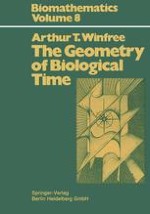1980 | OriginalPaper | Buchkapitel
Energy Metabolism in Cells
verfasst von : Arthur T. Winfree
Erschienen in: The Geometry of Biological Time
Verlag: Springer Berlin Heidelberg
Enthalten in: Professional Book Archive
Aktivieren Sie unsere intelligente Suche, um passende Fachinhalte oder Patente zu finden.
Wählen Sie Textabschnitte aus um mit Künstlicher Intelligenz passenden Patente zu finden. powered by
Markieren Sie Textabschnitte, um KI-gestützt weitere passende Inhalte zu finden. powered by
Cells have three alternative means of procuring energy for digestion and biochemical synthesis, for maintaining concentration gradients, for muscular contractions and cell division, and for maintaining body heat:1.Photosynthesis : The chloroplasts of green plants capture photons to convert ADP to ATP. Water is split to reduce NADP to NADPH, releasing oxygen.2.Respiration: The mitochondria use that oxygen and convert ADP to ATP. In the process, NADH is oxidized to NAD and water.3.Glycolysis: Lacking illuminated chloroplasts or lacking oxygen, cells metabolize sugars by fermentation to make a little ATP from ADP. Historically, this was probably the first way to make the high-energy pyrophosphate bond of ATP. All cells maintain this pathway. Most cells fall back on glycolysis only when they have no better alternative, but it is common to have no better alternative. The microorganisms of yogurt, sauerkraut, gangrene, and food poisoning, for example, subsist wholly on glycolysis, as do faculative anaerobes such as intertidal bivalves (e.g., oysters) and parasitic helminths (e.g., schistosomes) and diving vertebrates (e.g., green sea turtles) during their prolonged periods of contented abstinence from respiration. Red blood cells have no other energy supply. Poorly vascularized tissue such as the cornea of the eye, compact tumors, and embryos rely heavily on glycolysis for their energy needs.
